Summary
Diagenetic evolution makes a significant contribution to the quality of carbonate reservoir. A detailed geological work was undertaken in a quarry outcrop in Hai Phong city, in the North-Eastern area of Vietnam as the first step in better understanding and gaining an insight into the complex diagenetic evolution of carbonate play. This work integrates the results of detailed mapping and interpretation of lithologies and fracture orientations, along with detailed petrographic and isotopic analyses. Across the units exposed in the studied quarry, textures and isotopic signatures remaining in the out crop, illustrate the diagenetic history of three substages of diagenetic processes (eogenetic, mesogenetic and telogenetic) that has driven both poroperm reduction and enhancement. Only the most recent overprint has enhanced the poroperm via secondary poroperm features, such as vugs, solution-enlarged fractures (vuggy fractures), channels, and cavernous porosity, generated by a combination of uplift and meteoric mixing dissolution. Significant levels of poroperm in fractured Devonian carbonates in the region are predominant by NE-SW fracture sets that are created and enlarged in the telogenetic realm. Equivalents to the most important telogenetic substage, recorded in outcrop, likely occur in offshore Devonian subsurface carbonate reservoirs.
Key words: Diagenetic substages, stable isotope, poroperm, enhance, Trang Kenh formation.
1. Introduction
For many years, carbonates have been considered a potential reservoir offshore in the North-Eastern area of Vietnam. However, the geological characterisation of this carbonate reservoir is so far questionable due to its complex reservoir properties. Until now, many wells testing this play type offshore Northern Vietnam have been failures or show low flow rates, even though they were drilled in high karsted carbonate structures (buried hills). So, the question that needs to be answered for this play is: why did they fail and how can we target more successfully in this play type? To answer this, an analog of geological carbonate reservoir needs to be developed, as the first step in better understanding and gaining an insight into the complicated poroperm development of carbonate plays. We need to understand the relative timing of the various diagenetic processes, fracture characteristics and fluid evolution that occlude or enhance porosity and permeability. Studying such a reservoir analog in outcrop, at a play-relevant scale, is the goal of this current study.
2. Methodology
The studied outcrop is in an abandoned quarry (20o58'40''N latitude and 106o41'43''E longitude), in Minh Tan commune, Thuy Nguyen district, Hai Phong city (Figure 1). This quarry is located in the Western area of Bac Bo gulf and in the Trang Kenh formation (D2gv-D3tk), which also includes the various islands of Ha Long Bay, and consists of dark grey Devonian limestone containing abundant corals, stromatoporoids and some brachiopods [5]. The outcrop in the studied quarry is quite fresh and of sufficient quality for the thin section, XRD and isotope analysis.
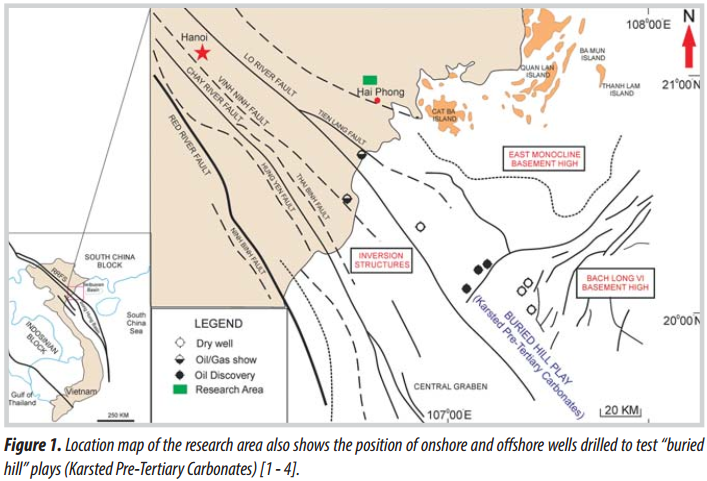
2.1. Field work
In outcrop, the following rock-types are present: matrix-supported mudstone, wackestone, packstone and grainstone (based on the combination of field textures and thin section analysis). Both black limestone and grey limestone are recognised in field and show a strong reaction with 10% HCl. Speleothems, carbonate soils in caves, open vugs and caverns are obvious as crosscutting exposures in the quarry walls (Figure 2b). In the field, early marine cement linings to voids and yellow to buff brown rock types were mapped, this was latter shown in thin section and XRD results to be dolostones and dolomitic limestones.
Carbonate in outcrop is observed as the massive or thick laminated carbonate with mostly high dip angles of bedding (40o - 65o), that is affected by multi phases of folding following NW-SE axes. The black limestone areas are distributed by flank of two small anticlines as in Figures 2b and 2c.
A total of 193 fracture sets were measured, including calcite veins (mineralised fractures that are calcite filled) and open fractures across the studied quarry. Open fractures in the quarry have more than two trends: a major WNW-ESE trend, and two minor trends of NNE-SSE and NE-SW. The calcite vein orientations can be divided into two trends; with a major NNW-SSE trend and a minor NE-SW trend. That could be affected by the first activity of the Song Hong fault zone resulted from ENE regional compression (80o) during the Oligocene-Miocene to create the major NNW-SSE open fracture trending, later filled by calcite (calcite veins). The second activity, NNW regional compression from 330o -350o during the Pliocene-Quaternary, generates the major WNW-ESE open fractures following the evidences of the Song Hong fault zone in the Paleozoic carbonate strata of Cat Ba island [6].
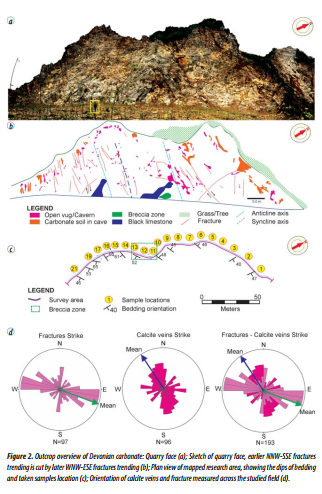
2.2. Petrography and XRD
Based on detailed study of the various units exposed in the quarry, 19 representative samples were collected (Figure 2b). These samples were slabbed in the lab and photographed. Once textures were identified, a subset of texture-aware samples was selected for isotope, thin-section and XRD analysis. Observations and measurements made in the field, as well as in the laboratory, are now presented.
Petrography and XRD were done to better identify the mineral variety and textures observed in the outcrop. Early marine cement textures such as morphology, distribution patterns or crystals sizes are visible both in the field and in thin section (Figure 3a). In the middle zones (turquoise arrow, Figure 3b), of cement-filled pores, blocky calcite with pink to red stained colour, higher iron content, indicates later and hotter burial cement phases. Early medium-grained (10 - 100μm) dolomite lacks stain in thin sections (Figure 4).
Black limestone shows the lithology is unstained (calcite) with local black or darker zones that could be due to deposition in a marine environment that was enriched in algae and organic material (Figure 5). XRD confirms the most abundant mineral is calcite.


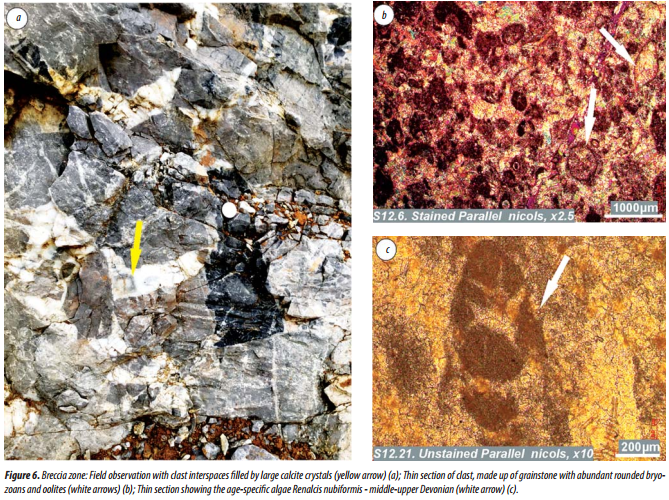
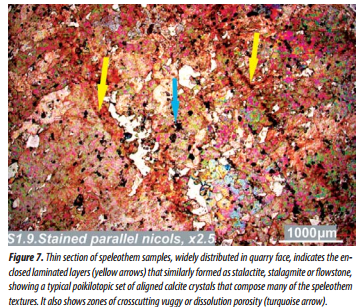

Breccia zones (Figures 2b, 2c, and 6) developed by tectonic activities (damage zones formed) or karst collapse, include the large calcite crystals infilling the interspace between the breccia clasts that were sampled and slabbed for thin section, XRD and isotope analysis. Clasts show a variable packstone to grainstone matrix with bryozoans and oolites clearly visible in thin section.
Speleothems, via meteoric water percolating from overlying soil or bedrock surface in crosscutting cavities and fissures, are abundant in the quarry face (Figures 2 and 7).
The effects of mechanical and burial compaction are clearly visible in thin section. Figure 8a indicates the stress-induced deformation in calcite vein (calcite- filled existing fractures) formed in the later stage of mesogenesis. Stylolite in Figure 8b is the typical evidence of on-going burial stress, that documents localised pressure solution leading to porosity shutdown in most ancient carbonates residing in mesogenetic substage [7]. In the later period, vugs and fractures, formed by the dissolution and compaction processes, tend to be more obvious, which can have significant roles in improving fractured reservoir quality (Figures 8c and 8d).
2.3. Isotopes
One hundred isotope samples were collected from slabbed rock sample faces which contain these eight categories in order to capture the fluid history of the various textures and lithologies. Three groups contain eight categories defined based on the textures and lithologies seen in a combination of outcrop, thin section and XRD as described in the previous section, namely: 1) early marine cement, 2) dolomite, 3) partly dolomite, 4) grey limestone, 5) black limestone, 6) calcite vein, 7) calcite in breccia zone and 8) speleothem. The resulting bivariate isotope plot listing the relevant δ18O and δ13C values is presented in Figure 9.
- Group 1 retains on the basic trend of somewhat decreasing (but positive) δ13C values from 3‰ to 0‰ (only one carbon value in this trend is negative, i.e., less than 0‰), combined with increasingly negative oxygen values ranging from -4‰ to -12‰. This covariant C-O trend is widely accepted as indicating ongoing burial re-equilibration and recrystallisation tied to increasing temperature and burial depths [7, 8].
- Group 2 (blue points, Figure 9) made up of δ13C values in the range 0‰ to +3‰ with strongly depleted δ18O values from -12‰ to -16‰. These are the most negative (hottest) oxygen values in all the collected samples from calcite-vein filled in interspaces between the matrix clasts of the breccia zone. The highly negative oxygen values suggest the possibility of hydrothermal fluids flowing though the breccia zone. The brittle-response tectonics created entry permeability, via brittle fracture to fluids from or in a hot deep part of the mesogenetic realm.
This event took place well after matrix poroperm was lost, as evidenced by the complete separation in oxygen value clusters between Groups 1 and 2. These hydrothermal fluids could be related to deep burial and Paleozoic orogeny, or to Tertiary- age deformation and uplift related to major Song Hong fault movements and active hydrothermal circulation tied to the effects of Himalayan Orogeny.
- Group 3 (Figure 8) shows moderately to strongly depleted δ13C values ranging from -2‰ to
-14‰ and a narrower range of δ18O values from -6‰ to -11‰. This group includes some calcite veins and a set of speleothems that are the precipitates of modern meteoric waters.
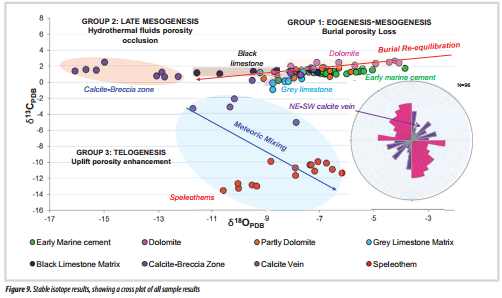

3. Discussion
There are three diagenetic substages presented in all ancient sedimentary carbonates, namely eogenetic, mesogenetic, and telogenetic. Each of the three drives diagenetic substages that can change the intensity of cementation, dolomitisation, compaction, replacement, recrystallisation and solution.
Porosity in the carbonates of study area evolved via dissolution, cementation and dolomitisation, first driven by both subaerial and subaqueous processes in eogenetic realm (Figures 3 and 4). The isotope signature shows these early marine cements and early dolomites re-equilibrated once they entered the mesogenetic realm (Group 1 - burial trend). The prevalence of radiaxial calcite in the current study area implies these Devonian carbonates of Trang Kenh formation also experienced significant eogenetic porosity loss. Based on thin section analysis done in the study area, later dolomite and ferroan calcite (Figure 4) indicate the effects of deeper burial with hotter mesogenetic fluids. The replacement of earlier carbonate by saddle or sutured dolomite and/or calcite recrystallisation during deep burial diagenesis further reduces porosity. Zones of such porosity destruction are indicated by a depletion both δ18O and δ13C isotope signature values (Figure 9). Ultimately, no eogenetic or early mesogenetic porosity and permeability remains in the deeper parts of the mesogenetic realm as seen in the thin section analysis (Figure 3 - Figure 5 and 3, 9, 12, 14 samples location in Figure 2c).
When the telogenesis occurs, the carbonate reservoir is exhumed to shallower depth and ultimately to exposure under subaerial condition. The isotope signature of the meteoric mixing trend is present in the study are, and recognised by more negative δ13C values (more exposure to carbon from soil gas weathering) and less negative δ18O values (Figure 8; uplift corresponds to temperature decrease).
Speleothems, formed as meteoric waters pass through vadose zone, have a significant influence on secondary porosity. The newly developed vuggy and fissure porosity have been observed at both the field and thin section scale (Figure 7). This figure illustrates a variety of pore sizes ranging from tiny vugs to caverns, as well as solution enhanced joints and fissures seen in outcrop. At all scales, telogenesis mostly helps create effective porosity in an otherwise tight carbonate, dissolved by meteoric water.
Fractured zones, solution-enlarged open fractures and channels are widespread in outcrop (Figure 10). These fractures were enlarged by dissolution (vuggy fracture) and now play a significant role in poroperm enhancement, as well as efficient conduits. Dissolution and further fracture porosity enhancement, recognised in this outcrop, can also occur in the subsurface when rocks and water are out of chemical equilibrium [9].
Both major NNW-SSE calcite vein and major WNW-ESE open fracture orientations in study area likely correspond to strike-slip displacement of Song Hong fault zone (Figure 1). The minor NE-SW calcite vein and fracture trending could be generated by compression during strike-slip. As discussed above, the meteoric water will enhance the poroperm evolution in carbonate reservoirs. Based on isotope signatures, the NW-SW trending calcite veins, that were affected by meteoric mixing, are dominant (Figures 9 and 11).
This observation is useful evidence for future drilling orientations designed to maximise open fracture intersections, as NE-SW trending fractures are related to the modern meteoric environment. Most nearby offshore wells testing the “buried hill” carbonate play have been drilled as vertical wells either on the crest of structures, or following zones of the major fault (fracture) damage, but none have focused on fissure trends related to preferential directions of telogenetic enhancement.
Therefore, a future “buried-hill” well should be designed to maximise penetrations of the better open-fracture orientations as well as to test multiple intersections with meteoric mixing trending fractures, which much more enhance the vuggy and fractures, rather than drilling another test of the so-far unsuccessful assumption that hydrocarbons in buried hills reside in a leached and porous cap structure. The current study shows there is likely little potential for widespread matrix storage in a buried hill play hosted in Devonian carbonates.
Successful exploration for this type of “buried- hill” target requires deviated drilling and the ongoing integration of core, log, seismic, and borehole image data in order to define and predict the poroperm distribution in such subsurface reservoir. More integrated approaches using the seismic attributes to detect the major faults zone, FMI to determine the fracture orientation in the play area, and an isotope analysis of cuttings to evaluate whether a meteoric mixing zone has been intersected, may define future drilling successes, rather than failures, in this as yet under-explored region of Northern Vietnam.
All substages of diagenetic processes affecting poroperm development and relevant to the study area are summarised in Table 1.
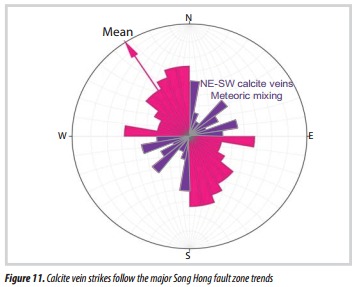

4. Conclusion
Field study integrated with petrographic and stable isotope determinations clearly defines all three sets of substages (eogenetic, mesogenetic and telogenetic) remaining in the outcrop, but only the most recent telogenetic overprint has created the porosity and permeability. Poroperm has been destroyed by mesogenetic cementation, dolomitisation, replacement, recrystallisation and compaction. However, porosity and permeability are enhanced in zones of telogenesis. secondary poroperm features, such as vugs, solution- enlarged fractures (vuggy fractures) and channels, and cavernous porosity is generated via major dissolution activity driven by a combination of both uplift and meteoric mixing.
Fracture and calcite vein sets are mainly caused by the tectonic and hydrothermal activities that correspond to the background structural elements and their diagenetic evolution. NE-SW calcite vein signatures are related to meteoric mixing fluids. This oriented subset of telogenetic processes has significantly enhanced poroperm values in open fractures in what is an otherwise tight carbonate matrix system.
This outcrop study is the first step to understand Paleozoic fractured carbonate reservoir plays in subsurface, offshoreVietnam. Combining all interpretation of logs, FMI, cutting data and seismic attributes, core, and thin section analysis results will help develop insightful understanding leading to future drilling success.
References
1. Michael Bryld Wessel Fyhn, Lars Henrik Nielsen, Lars Ole Boldreel. Cenozoic evolution of the Vietnamese coastal margin. Geological Survey of Denmark and Greenland Bulletin. 2007; 13: p. 73 - 76.
2. L.H.Nielsen, A.Mathiesen, T.Bidstrup, O.V.Vejbæk, P.T.Dien, P.V.Tiem. Modelling of hydrocarbon generation in the Cenozoic Song Hongbasin, Vietnam: Ahighlyprospective basin. Journal of Asian Earth Sciences. 1999; 17(1, 2): p. 269
- 294.
3. Trinh Xuan Cuong, Phan Ngoc Trung, Tong Duy Cuong, Nguyen Bich Ha, Phung Lan Phuong, Hoang Thi Lan, Nguyen Hoang Son. Hydrocarbon systems in the North-Eastern area of the Song Hong basin. Journal of Earth Science and Engineering. 2013; 3: p. 807 - 814.
4. Nguyen Van Hoang, Nguyen Anh Duc. A study of fractured carbonate in Blocks 102-106 by wireline logging. Petrovietnam Journal. 2014; 11: p. 23 - 28.
5. Tong Duy Thanh, Vu Khuc. New stratigraphic schema of Paleozoic and Mesozoic in Bac Bo (North Vietnam). Journal of Geology. 2002; 19, 20: p. 1 - 13.
6. S.A.Kasatkin, V.V.Golozubov, Phung Van Phach, Le Duc Anh. Evidences of Cenozoic strike slip dislocations of the Red River fault system in Paleozoic carbonate strata of Cat Ba island (Northern Vietnam). Tikhookeanskaya Geologiya. 2014; 33(3): p. 14 - 28.
7. Clyde Moore, William J.Wade. Carbonate reservoirs (2nd edition): Porosity and diagenesis in a sequence stratigraphic framework. Elsevier. 2013.
8. John Warren, Christopher K.Morley, Thasinee Charoentitirat, Ian Cartwright, P.Prueksarat Ampaiwan, Patcharin Khositchaisri, Maryam Mirzaloo, Jakkrich Yingyuen. Structural and fluid evolution of Saraburi Group sedimentary carbonates, central Thailand: A tectonically driven fluid system. Marine and Petroleum Geology. 2014; 55: p. 100 - 121.
9. Wayne M.Ahr. Geology of carbonate reservoirs: the identification, description, and characterization of hydrocarbon reservoirs in carbonate rocks. Wiley. 2008.